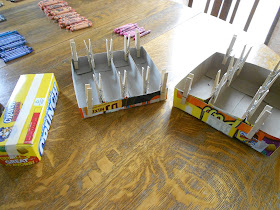
Place the food in the jar, spaced out as much as possible.

Spray a quick misting of water over the food.

Observe the wet food (this is not really necessary, just kind of fun).

Screw the lid, tightly, onto the jar.

Place the jar into the back of a dark cupboard, and forget about it.
Actually, you might want to check the jar each day to see how your mold is progressing. Just don't open the jar - you don't want to breath in the mold. But, whether you check it, or just forget about it, in a few days, you will have a lovely collection of the stuff.

 At least, that's what we understand from the project pages at the back of Frances O'Roark Dowell's Phineas L. MacGuire...gets Slimed!, the second book from The Highly Scientific Notebooks of Phineas L. MacGuire, and our family read-a-loud for the week.
At least, that's what we understand from the project pages at the back of Frances O'Roark Dowell's Phineas L. MacGuire...gets Slimed!, the second book from The Highly Scientific Notebooks of Phineas L. MacGuire, and our family read-a-loud for the week.Our mold terrarium (the second of three mold related projects at the back of the book, and the only one I would agree to letting the children do - I drew the line at making our own penicillin, with a dusty lemon wedge, or growing slime mold on a rotting piece of bark) is new, so we don't actually have any mold, yet.
While I was less than enthusiastic about a few of the projects, the children and I really enjoyed the book about fourth grader Phineas L. MacGuire, who has aspirations of being the best fourth grade scientist ever, but so far has only won honorable mention at the his school's science fair.
The book could easily be read alone by the 8-12 year old set, with simple vocabulary, and a generous smattering of entertaining, pencil drawn, illustrations. But, while the interplay between characters, has a quirky, Cleary-esque style, there is just enough Nickelodeon-type irreverence for authority thrown in, in the name of humor, to make it a good, family discussion starter. That, coupled with a fair amount of scientific content, in this case dealing with the fungi kingdom, makes Dowell's book perfect as a read-a-loud.
We already have the two additional books from the series on hold at the library. So, watch for mold terrarium updates, as well as more Phineas L. MacGuire inspired science themed fun, here, in the future.
In the meantime, check out this week's What My Child is Reading link-up, hosted by Mouse Grows, Mouse Learns, for additional children's book reviews and recommendations, or the Science Sunday links, at Adventures in Mommydom, for more science themed fun, and ideas for children.
It's great to be a homeschool.















































